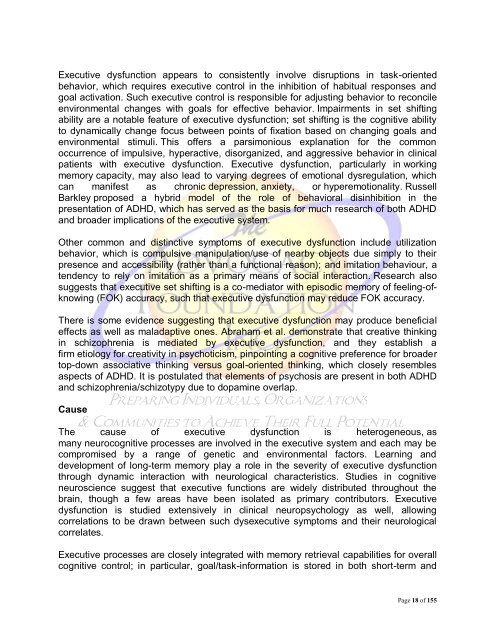Organizational Dysfunction
Organizational Dysfunction
Organizational Dysfunction
You also want an ePaper? Increase the reach of your titles
YUMPU automatically turns print PDFs into web optimized ePapers that Google loves.
Executive dysfunction appears to consistently involve disruptions in task-oriented<br />
behavior, which requires executive control in the inhibition of habitual responses and<br />
goal activation. Such executive control is responsible for adjusting behavior to reconcile<br />
environmental changes with goals for effective behavior. Impairments in set shifting<br />
ability are a notable feature of executive dysfunction; set shifting is the cognitive ability<br />
to dynamically change focus between points of fixation based on changing goals and<br />
environmental stimuli. This offers a parsimonious explanation for the common<br />
occurrence of impulsive, hyperactive, disorganized, and aggressive behavior in clinical<br />
patients with executive dysfunction. Executive dysfunction, particularly in working<br />
memory capacity, may also lead to varying degrees of emotional dysregulation, which<br />
can manifest as chronic depression, anxiety, or hyperemotionality. Russell<br />
Barkley proposed a hybrid model of the role of behavioral disinhibition in the<br />
presentation of ADHD, which has served as the basis for much research of both ADHD<br />
and broader implications of the executive system.<br />
Other common and distinctive symptoms of executive dysfunction include utilization<br />
behavior, which is compulsive manipulation/use of nearby objects due simply to their<br />
presence and accessibility (rather than a functional reason); and imitation behaviour, a<br />
tendency to rely on imitation as a primary means of social interaction. Research also<br />
suggests that executive set shifting is a co-mediator with episodic memory of feeling-ofknowing<br />
(FOK) accuracy, such that executive dysfunction may reduce FOK accuracy.<br />
There is some evidence suggesting that executive dysfunction may produce beneficial<br />
effects as well as maladaptive ones. Abraham et al. demonstrate that creative thinking<br />
in schizophrenia is mediated by executive dysfunction, and they establish a<br />
firm etiology for creativity in psychoticism, pinpointing a cognitive preference for broader<br />
top-down associative thinking versus goal-oriented thinking, which closely resembles<br />
aspects of ADHD. It is postulated that elements of psychosis are present in both ADHD<br />
and schizophrenia/schizotypy due to dopamine overlap.<br />
Cause<br />
The cause of executive dysfunction is heterogeneous, as<br />
many neurocognitive processes are involved in the executive system and each may be<br />
compromised by a range of genetic and environmental factors. Learning and<br />
development of long-term memory play a role in the severity of executive dysfunction<br />
through dynamic interaction with neurological characteristics. Studies in cognitive<br />
neuroscience suggest that executive functions are widely distributed throughout the<br />
brain, though a few areas have been isolated as primary contributors. Executive<br />
dysfunction is studied extensively in clinical neuropsychology as well, allowing<br />
correlations to be drawn between such dysexecutive symptoms and their neurological<br />
correlates.<br />
Executive processes are closely integrated with memory retrieval capabilities for overall<br />
cognitive control; in particular, goal/task-information is stored in both short-term and<br />
Page 18 of 155

















